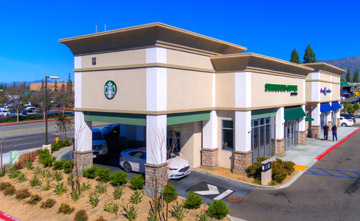As published on Connect.Media on June 19, 2018
 Acquiring and selling shopping center outparcels, or what are known as net lease assets, remains a popular investment strategy. For shopping center and pad owners alike, it’s important to be aware of operational issues that could adversely affect the parties, if not understood in advance.
Acquiring and selling shopping center outparcels, or what are known as net lease assets, remains a popular investment strategy. For shopping center and pad owners alike, it’s important to be aware of operational issues that could adversely affect the parties, if not understood in advance.
Connect Media spoke with Coreland Companies’ Vicky Hammond, a vice president at the SoCal-based commercial real estate management and brokerage firm, to find out how to protect a center’s operations over time, despite the fragmentation underway today.
Q: How can you guard against numbers getting lost in translation in an out-parcel transaction?
A: One priority is to ensure there’s an understanding of an out-parcel tenant’s expense reimbursement requirement, versus the out-parcel owner’s subsequent obligation to the overall shopping center manager.
Due diligence may uncover slippage occurring when the tenant is required to reimburse expenses on building square footage pro rata allocations, yet the out-parcel owner is required to reimburse shopping center management based on land square footage pro rata.
For instance, a 3,000-square-foot drive-thru pad tenant within a 100,000-square-foot shopping center is required to reimburse 3% of expenses based on a building pro rata share. However, if the owner of the out-parcel is required to reimburse shopping center management based on a land allocation, and the out-parcel land square footage is 25,000 square feet versus shopping center land of 200,000 square feet, the expense reimbursement share is 12.5%. Thus, the out-parcel owner will lose the 9.5% difference in allocation methods, meaning if the reimbursed expenses are $100,000 the lost expense share would equal $9,500.
Q: Which party is responsible for expenses, tenants or shopping center buyers?
A: As a shopping center buyer, it’s common to acquire on the premise out-parcel tenants take full responsibility for expenses, but it is not always the case. Tenants or out-parcel owners generally have responsibility for various expenses on their parcel, such as landscaping, insurance, property taxes and maintenance of the building. However, without well-defined language in a REA, CC&R or other operating agreements, there are expenses such as security, drive aisle expenses, signage, sweeping and lighting, which benefit the entire center, but may not be reimbursed by an out-parcel.
Seek to understand this early in the due diligence process to more accurately project a property’s NOI and resulting value.
Q: How important is collaboration among multiple ownership interests?
A: Verify there are well-written documents providing for one entity to manage the overall shopping center to protect the long-term health of the property. A shopping center with four different ownership groups acting independently will inevitably lack uniformity and consistency.
Operating documents should ensure the center operates in a uniform, first-class manner. Out-parcel owners should be held accountable to meet standards of daily maintenance, operations and repair of major damage, and/or reimburse other owners for the cost of same. In addition, issues of use, construction, abandonment, parking, and a host of other items impacting shopping center operations and performance should be addressed.
Copyright © 2018 Connect Group Media. All rights reserved – https://www.connect.media/fragmented-shopping-centers-how-to-protect-a-centers-long-term-operations/

